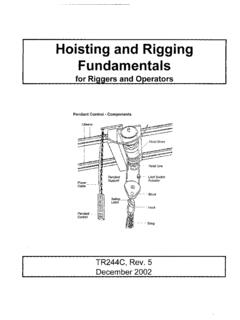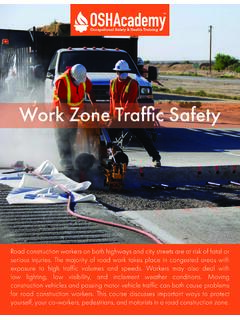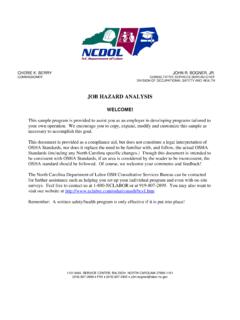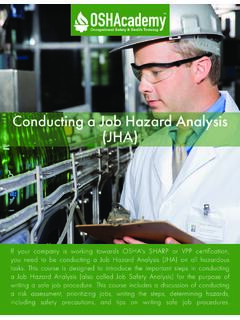Transcription of Electrical Safety For Employees - OSHAcademy
1 This course provides a brief one-hour overview of basic Electrical Safety on the job. Emphasis is placed on the various Electrical hazards encountered in the workplace, and how to protect yourself from those Safety For EmployeesBasic This page intentionally blank OSHA cademy Course 115 Study Guide Electrical Safety Basic Copyright 2020 Geigle Safety Group, Inc. No portion of this text may be reprinted for other than personal use. Any commercial use of this document is strictly forbidden. Contact OSHA cademy to arrange for use as a training document.
2 This study guide is designed to be reviewed off-line as a tool for preparation to successfully complete OSHA cademy Course 115. Read each module, answer the quiz questions, and submit the quiz questions online through the course webpage. You can print the post-quiz response screen which will contain the correct answers to the questions. The final exam will consist of questions developed from the course content and module quizzes. We hope you enjoy the course and if you have any questions, feel free to email or call: OSHA cademy 15220 NW Greenbrier Parkway, Suite 230 Beaverton, Oregon 97006 +1 (888) 668-9079 Disclaimer This document does not constitute legal advice.
3 Consult with your own company counsel for advice on compliance with all applicable state and federal regulations. Neither Geigle Safety Group, Inc., nor any of its Employees , subcontractors, consultants, committees, or other assignees make any warranty or representation, either express or implied, with respect to the accuracy, completeness, or usefulness of the information contained herein, or assume any liability or responsibility for any use, or the results of such use, of any information or process disclosed in this publication. GEIGLE Safety GROUP, INC., DISCLAIMS ALL OTHER WARRANTIES EXPRESS OR IMPLIED INCLUDING, WITHOUT LIMITATION, ANY WARRANTIES OF MERCHANTABILITY OR FITNESS FOR A PARTICULAR PURPOSE.
4 Taking actions suggested in this document does not guarantee that an employer, employee, operator or contractor will be in compliance with applicable regulations. Ultimately every company is responsible for determining the applicability of the information in this document to its own operations. Each employer s Safety management system will be different. Mapping Safety and environmental management policies, procedures, or operations using this document does not guarantee compliance regulatory requirements. Revised: September 2, 2020 This page intentionally blank Course 115 Contents Modules and Learning Objectives.
5 1 Module 1: Electrical Hazards .. 2 Introduction .. 2 How Standards Minimize Hazards .. 3 The Value of an Electrical Safety Program .. 3 Recognizing Hazards .. 4 Terms You Need to Know .. 5 What Affects the Flow of Electricity? .. 6 How Does Water Affect the Flow of Electricity? .. 6 What Causes Shocks .. 6 Shocks Effect On The Body .. 7 Low Voltage Does Not Mean Low Hazard .. 7 Burns .. 9 High Voltage .. 10 Why People Freeze .. 10 Static Electricity .. 11 Overload Hazards .. 12 Module 2: Protective Measures .. 13 Protect Against Electrical Hazards .. 13 Insulation.
6 13 Types of Insulation .. 13 Guarding .. 14 Course 115 Grounding .. 15 Circuit Protection Devices .. 15 Safe Work Practices .. 16 Protection from Energized Parts .. 17 Protection Against Unexpected Startup .. 18 Protection from Overhead Power Lines .. 18 Electrical Protective Equipment .. 20 Tools .. 20 Training Requirements .. 21 Course 115 Copyright 2020 Geigle Safety Group, Inc. Page 1 of 22 . Modules and Learning Objectives Module 1 - Electrical Hazards Learning objectives in this module include: Identify and describe the two primary OSHA Electrical Safety standards.
7 Describe the benefits of an Electrical Safety program. Identify at least 10 Electrical hazards commonly found in the workplace. Define "volt," "ampere," and "ohm." Discuss the difference between a series and parallel Electrical circuit. Describe the factors that cause Electrical shocks. Discuss the hazards associated with working around high voltage. Describe the hazards associated with static electricity. Discuss how overload conditions occur and Electrical protective devices. Module 2 - Protective Measures Learning objectives in this module include: List the three factors causing most Electrical injuries.
8 Describe the importance of and types of Electrical insulation. Describe methods for effectively guarding Electrical equipment. Define the term, "grounding," and give examples. List and give examples of circuit protection devices. Describe general safe work practices when working around Electrical circuits. Discuss how to protect against energized parts and unexpected startup. Describe protection while working around overhead power lines. Course 115 Copyright 2020 Geigle Safety Group, Inc. Page 2 of 22.
9 Module 1: Electrical Hazards Introduction Electricity is essential to modern life, both at home and on the job. Some Employees engineers, electricians, electronic technicians, and power line workers, among them - work with electricity directly. Others, such as office workers and sales people, work with it indirectly. Perhaps because it has become such a familiar part of our daily life, many of us do not give any thought to how much our work depends on a reliable source of electricity. More importantly, we tend to overlook the hazards electricity poses and fail to treat it with the respect it deserves.
10 OSHA standards cover many Electrical hazards in many different industries. OSHA's general industry Electrical Safety standards are published in: through Design Safety Standards for Electrical Systems, and through Electrical Safety -Related Work Practices Standards. OSHA also has Electrical Safety standards for: Construction - in 29 CFR 1926, Subpart K. Marine terminals - in 29 CFR 1917, and longshoring, in 29 CFR 1918 reference the general industry Electrical standards in Subpart S of Part 1910. Shipyard standards - 29 CFR 1915, cover limited Electrical Safety work practices in 29 CFR 24 states (in the United States) and 2 territories that operate their own OSHA-approved programs, the standards and other procedures governing Electrical Safety may not be identical to the federal requirements.











